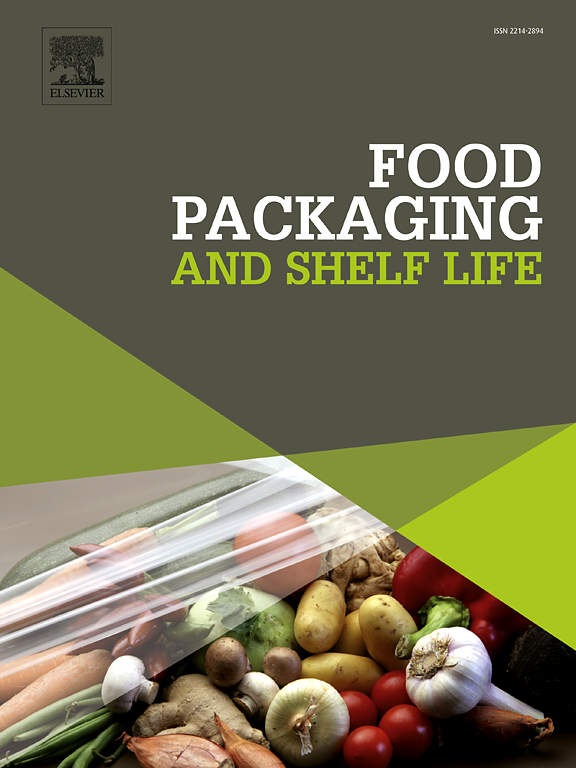利用蜂蜡热诱导相分离制备纳米纤维素的仿生疏水性:开发可持续食品包装材料的新策略及其使用寿命预测
IF 8.5
1区 农林科学
Q1 FOOD SCIENCE & TECHNOLOGY
引用次数: 0
摘要
本研究利用蜂蜡的热诱导相分离(TIPS)技术,通过诱导疏水性制备了一种疏水纤维素纳米纸。由于降低了水蒸气透过率(WVTR)和氧气渗透性,因此所得材料在食品包装应用中具有巨大的潜力,这在目前的情况下是非常理想的。蜂蜡通过氢键和疏水-疏水相互作用附着在纤维素纳米纤维上。采用FTIR、SEM、XRD、TGA和UTM对制备的疏水纤维素纳米纸进行了表征。蜂蜡改性纤维素纳米纸(BCNP)的水接触角为119°,抗拉强度为28.5 MPa。CNP中蜂蜡的TIPS导致了蜂蜡的精细涂层,随后导致水蒸气透过率(1.8 (g/h.m2))和氧气渗透率(38 Barrer)的大幅降低,这表明制备的BCNP可能是一种有效的食品包装材料。通过土埋试验对该材料的生物降解性进行了研究。采用BET分析法对材料的表面积和孔径进行了分析。所制备的材料具有在环境温度下有效保存番茄果实的能力。我们还使用Arrhenius方程来研究CNP和蜂蜡包覆CNP的使用寿命,代入在湿热老化研究中获得的抗拉强度值。因此,由疏水纤维素纳米纸通过TIPS制成的包装材料符合绿色发展战略,可能成为石油基包装材料的有前途的替代品本文章由计算机程序翻译,如有差异,请以英文原文为准。
Bio-inspired hydrophobicity in cellulose nanopaper via thermal-induced phase separation of beeswax: A new strategy to develop sustainable food packaging materials and its service life prediction
In this study, a hydrophobic cellulose nanopaper was developed by inducing hydrophobicity via the cost-effective and eco-friendly thermal-induced phase separation (TIPS) technique of beeswax. The resultant material suggests huge potential in food packaging applications due to the reduced water-vapour transmission rate (WVTR) and oxygen permeability, which is highly desirable in the current scenario. The beeswax adheres to the cellulose nanofiber through hydrogen bonding and hydrophobic-hydrophobic interactions. The fabricated hydrophobic cellulose nanopaper was characterized by FTIR, SEM, XRD, TGA and UTM. The beeswax-modified cellulose nanopaper (BCNP) showed a water contact angle of 119° and tensile strength of 28.5 MPa. The TIPS of beeswax in the CNP resulted in the fine coating of beeswax, which subsequently led to a substantial reduction in the water vapour transmission rate (1.8 (g/h.m2)) and oxygen permeability (38 Barrer), suggesting that the fabricated BCNP could be an effective packaging material for foodstuffs. The biodegradability study of the material has also been investigated via soil burial tests. The surface area and pore size of the material were analyzed by using BET analysis. The fabricated material has the ability to efficiently preserve the tomato fruit at an ambient temperature. We also investigated the service life of CNP and bee wax-coated CNP using the Arrhenius equation, substituting the tensile strength values obtained during the hygrothermal ageing studies. Therefore, the fabricated packaging material developed from hydrophobic cellulose nanopaper via TIPS aligns with green development strategies and could be a promising alternative to petroleum-based packaging materials
求助全文
通过发布文献求助,成功后即可免费获取论文全文。
去求助
来源期刊

Food Packaging and Shelf Life
Agricultural and Biological Sciences-Food Science
CiteScore
14.00
自引率
8.80%
发文量
214
审稿时长
70 days
期刊介绍:
Food packaging is crucial for preserving food integrity throughout the distribution chain. It safeguards against contamination by physical, chemical, and biological agents, ensuring the safety and quality of processed foods. The evolution of novel food packaging, including modified atmosphere and active packaging, has extended shelf life, enhancing convenience for consumers. Shelf life, the duration a perishable item remains suitable for sale, use, or consumption, is intricately linked with food packaging, emphasizing its role in maintaining product quality and safety.
 求助内容:
求助内容: 应助结果提醒方式:
应助结果提醒方式:


